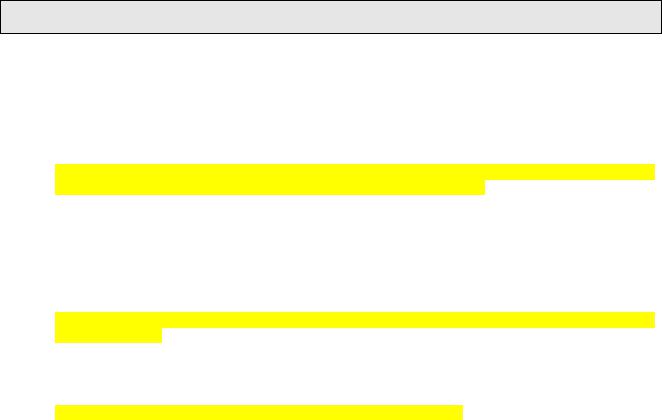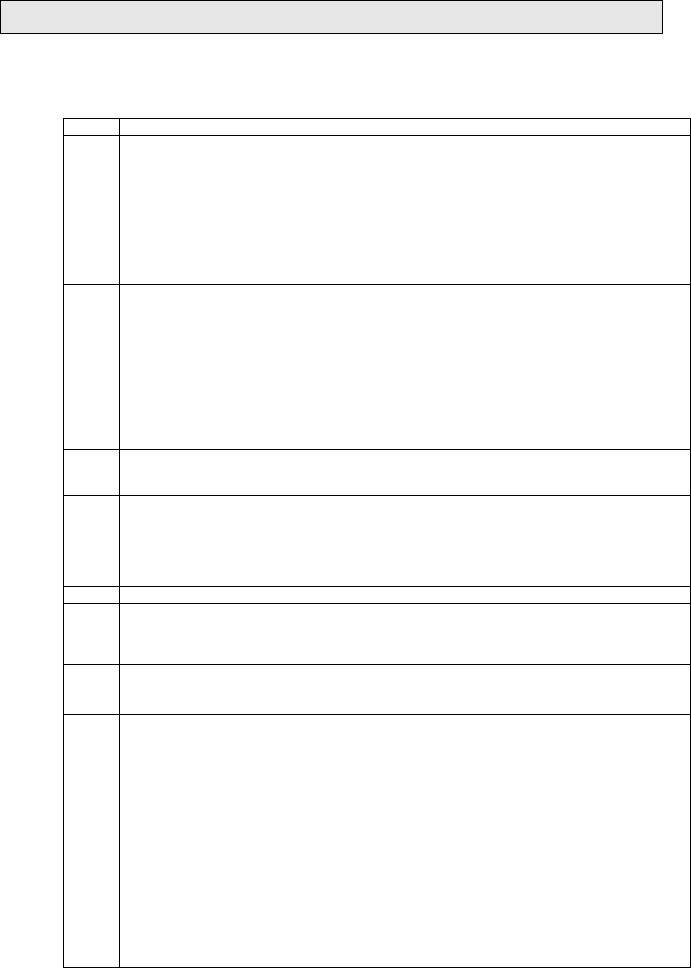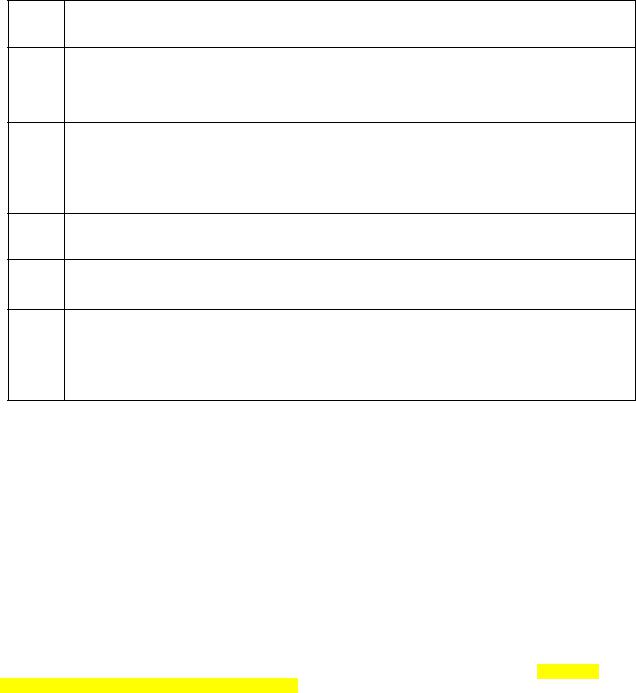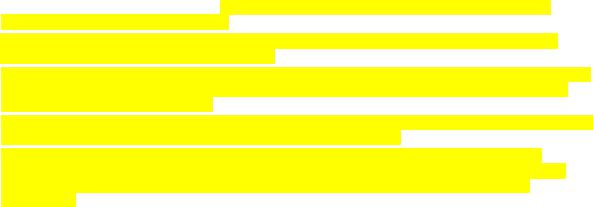
SIRE Vessel Inspection Questionnaire VIQ Ver.7007
.pdf4.1.2 Additional Requirements.
In addition to the general mandatory requirements list above, the Inspector: -
1.Must respond by entering the requested information or by checking one response box for each question;
2.Must, where guidance to a question is provided, consider all the guidance to determine how the question should be answered;
3.Must carefully consider and provide a proper response to every question;
4.Must use objective evidence when answering each question (the assurance of the vessel’s staff is insufficient evidence or proof);
5.Must include an explanatory Observation in the Observation section that accompanies a question when it is answered “No” or “Not Seen”. Where the VIQ question is answered “Not Applicable” or in cases where the guidance requires a comment regardless of how a question is answered, such comment must be recorded in the “Comments” section.
6.Must not use a “Yes” response to any question where an inspector’s Observation or Other comment contains negative elements (if there is such negative Observation or Other comment then the answer to that question should be “No”);
7.Must not, in any Other Comment or Additional Comments, include -
i.Any overall or partial ship rating or indication of ship acceptability / non-acceptability;
ii.Any matter unrelated to the topic of a VIQ chapter and, in particular, any matter unrelated to ship safety and pollution prevention; and,
iii.Any overall chapter ending or other partial summary of the inspector’s findings;
8.Must give the factual basis and specific reasons for any opinions or subjective comments made by the inspector;
9.Must note any deficiencies or inspector-observed conditions, to which action was taken whilst the inspector was on board, and
10.Must not offer any comments or opinions with regard to actions to be taken in respect of any deficiencies or observed conditions noted by the inspector.
11.Must not use the expression “we” in any Observation or Other comment unless the inspection was conducted by more than one inspector.
12.Must not at any time give any verbal indication of ship acceptability / non-acceptability.
13.Must not discuss or communicate by any means (verbal, written, electronic or otherwise) any findings, information gained or outcome of the inspection with any third party other than those with a legitimate involvement in the inspection process for that vessel.
14.Must not conduct any other inspection or be involved in the provision of any other services while conducting a SIRE inspection.
4.2Permitted Inspection Actions
Inspectors may:
1.Include in the “Comments” section accompanying any question, inspector comments even where the question is answered with a “Yes” provided such comments give useful information to the report recipient;
2.Respond to questions or provide comments on the basis of material not included in the guidance specified for the question but must note this reliance and explain reason for the reliance;
3.Include in the “Additional Comments’ for each chapter, any comments in respect of the subject matter not addressed by questions contained in the chapter additional to those that the inspector may make in response to the specific questions in the chapter; and
4.Respond to questions which are not applicable to either the vessel or its cargo by checking such questions “Not Applicable”.
© Copyright OCIMF 2019. All rights reserved. |
VIQ 7.0.07 – 22 February 2019 |
|
11 |
4.3Other Inspection Requirements.
1.Ship inspections shall not be conducted at night unless requested by the OCIMF Inspecting member. The vessel’s operator must also concur that it is safe to carry out a night inspection and that this will not negatively impact the vessel’s compliance with work and rest hour requirements.
2.Inspectors shall limit advance communications with vessels and vessel operators to that information necessary to arrange access and appropriate arrival to and from the vessel, or to communicate intended inspection plans. Inspectors shall not request information concerning the VIQ in advance of their arrival to a vessel. Inspectors shall not communicate with the vessel or vessel operator after completion of OCIMF inspection activities. Following an inspection all communication concerning the inspection shall be managed by the commissioning member.
3.The inspector should consider requesting that equipment be run and tested to confirm that it is in operational order and that officers and crew are familiar with its operation. The inspector must ensure that such requests do not cause delay or interfere with the safety and normal operation of the vessel and do not contradict any terminal requirements.
4.It should be recognised that the overall objective of the inspection is to provide the user of a
SIRE Report with a factual record of the vessel’s condition and standard of operation at the time of the inspection and, in turn, allow an assessment of the risk that use of the vessel might pose
5.A SIRE inspection is expected to be accomplished within an 8-10 hour period. The inspector must plan their time accordingly and make sufficient allowances to have this period of time available for the inspection. Inspectors must take into account the hours of rest requirements for the vessel’s staff that must be observed and ensure that the SIRE inspection does not interfere with these.
6.Under normal circumstances, a SIRE inspection will take place when a vessel is alongside in port whilst discharging or loading cargo. During the course of the inspection entry into ballast tanks and/or /void-spaces is discouraged. Assessment of the physical condition of ballast tanks/void spaces etc. can be made only in circumstances where the access hatches or plates can be removed, and the internals sighted from the deck. In any event, actual entry should only be made following specific written request from the inspecting company, with the authority of the Master and provided that port and terminal regulations allow it. In all cases, the enclosed space entry procedures set out in ISGOTT Chapter 10 must be strictly observed.
7.Travel for ship inspections on behalf of OCIMF member companies must, at all times, be conducted in a safe manner with due regard to industry best practice and any agreements between the inspector and member companies. Inspectors must ensure that they are able to safely conduct an 8-10 hour inspection without undue fatigue.
© Copyright OCIMF 2019. All rights reserved. |
VIQ 7.0.07 – 22 February 2019 |
|
12 |
SECTION 5
5.1The Distributed Report
The responses recorded in the Vessel Inspection Questionnaires (the Inspection Element) serve as the basis for development of the second element of the Vessel Inspection Procedure (the Report Element) distributed under the programme. The inspector’s completed VIQ must be reviewed by the submitting company prior to processing in the SIRE system and transmission to the vessel operator.
The processed VIQ is automatically converted into a report after the submitting company has processed it in the SIRE System. The report does not replicate the pages of the Vessel Inspection Questionnaire but is distributed in abbreviated form. It consists of a conversion of the inspector VIQ responses into a uniform report format. The report is divided into three sections as follows:
Section 1
General information
Section 2
Questions marked “Yes” without comment.
Section 3
Questions marked “No”, “Not Seen”, “Not Applicable” or otherwise commented upon and any chapter ending
Additional Comments.
-Contains the informational responses required in Chapter 1 of the VIQ plus answers to certain questions from other VIQ chapters where specific details or dates are required.
-Lists, by index number only, the questions in the VIQ which have been checked with a “Yes” response, but without inspector comment.
-Contains; in their entirety,
(a)All VIQ questions which have been answered with a “No”, or “Not Seen” response, as well as the comments made by the inspector to supplement such responses;
(b)All other VIQ questions which have otherwise been commented upon, together with the comment; and,
(c)Any additional comments made at the end of the VIQ chapters.
(d)In cases where a question has been answered with a “No" response, the element or sub-element of the OCIMF Tanker Management Self-Assessment (TMSA) for the ship to which the
“No" response refers, together with the operator’s assessment will be displayed, where appropriate. This feature will only be displayed to OCIMF members who have been granted by the operator access to their TMSA submission. Recipient members will not be able to view this TMSA feature within the report.
In some cases, the SIRE Report Editor will automatically enter “Not
Applicable response.
© Copyright OCIMF 2019. All rights reserved. |
VIQ 7.0.07 – 22 February 2019 |
|
13 |

Chapter 1. General Information
1.1Name of the vessel:
Note: Prefixes (MT, MV, SS etc.) must not be used unless they are actually a part of the registered name of the vessel. The name must be entered exactly as it appears on the Certificate of Registry.
1.2Vessel IMO Number:
1.3Date the inspection was completed:
If the inspection took place over two or more days, in two or more sessions, or was carried out by more than one inspector, record the arrival and departure details in comments.
1.4Was a full inspection of the vessel completed
If a full inspection of the vessel was not completed, please note the reasons why, and also the areas of the ship that were not inspected
1.5Port of inspection:
1.6Flag:
If a change of flag has taken place within the past 6 months, record the date of change and the previous flag in Comments.
1.7Deadweight: (metric tonnes)
Note: For vessels with multiple load line certificates, record the maximum of the assigned deadweight’s.
1.8Date the vessel was delivered:
Any periods of lay up since delivery should be recorded in Comments.
The date of delivery from the original builder as listed in the IOPPC must be recorded. If the date of delivery is not recorded in the IOPPC Form A or Form B, the date of delivery as contained in Safety Construction Certificate must be recorded. If the vessel has been 're-aged', the original build date must be recorded.
1.9Name of the OCIMF inspecting company:
Note: The SIRE Report Editor software automatically inserts the name of the inspecting company.
1.10Date and time the inspector boarded the vessel:
1.11Date and time the inspector departed the vessel:
If the inspection took place over two or more days, in two or more sessions, or was carried out by more than one inspector, record the arrival and departure details in Comments.
If the inspection was authorised to be conducted at night, the reason(s) for the night inspection should be recorded in comments.
Inspectors are required to depart the vessel as soon as the inspection has been completed and after the closing meeting has been conducted. In the event that an inspector does not leave the vessel upon completion of the inspection, the reason(s) shall be recorded in comments.
1.12Time taken for inspection.
Note: Record the time taken to conduct the inspection to the nearest 5 minutes. This is the actual time of inspection and does not include the times the inspection was suspended for any reason (e.g. Lunch, PSC inspection etc.).
If the inspection was conducted over two or more sessions, record the reason(s) for this e.g. cargo availability, berth congestion, weather, other ongoing ship-inspection such as PSC, Administration, Class Survey etc should be recorded in Comments.
1.13Name of the inspector:
Note: The VIQ software automatically inserts the name of the inspector. This is for use by the Inspecting Company and for OCIMF internal purposes only and will not be displayed on the delivered report.
© Copyright OCIMF 2019. All rights reserved. |
VIQ 7.0.07 – 22 February 2019 |
|
14 |

1.14 Is an up to date OCIMF Harmonised Vessel Particulars Questionnaire (HVPQ) maintained and is it readily available?
The HVPQ, compiled using OCIMF HVPQ software should be available on board and randomly reviewed by the inspector for accuracy. It is not essential that the HVPQ is provided in paper form and inspectors are not expected to seek a paper copy from the vessel.
1.15 Vessel’s operation at the time of the inspection:
Loading |
Discharging |
Bunkering |
Ballasting |
Deballasting |
At anchor |
Idle |
At sea |
|
|
|
|
|
|
|
|
River transit |
Repairs afloat |
In drydock |
STS loading |
STS discharging |
Cooling Down |
Gassing-up |
|
|
|
|
|
|
|
|
|
Note: If the vessel is conducting any other operation than that listed, such as desloping, etc., the vessel's operation is to be recorded as 'Idle' and the activity being performed recorded in comments.
So called ‘Engineered Operations’ are not acceptable and should not change the operation at the time of inspection.’ Engineered Operations’ include but are not limited to Internal recirculation, transferring internally from one tank to another, or an STS operation where cargo is transferred from one vessel to another and then transferred back again.
1.16 Product(s) being handled:
Crude Oil |
Dirty petroleum products |
Dirty petroleum products |
Clean petroleum |
Vegetable oils |
|
(low flash) |
(high flash) |
products |
|||
|
|
||||
|
|
|
|
|
|
Animal oils |
Chemicals |
Liquefied gas |
Other (specify) |
|
|
|
|
|
|
|
Notes: A volatile product is petroleum having a flash point below 60 DEG C as determined by the closed cup method of testing. If a cargo is being handled at a temperature within 10 DEG C of its flashpoint, it should be considered volatile. Therefore, a cargo with a flashpoint of 80 DEG C should be considered volatile if handled at a temperature of 70 DEG C or above.
Inspectors should NOT state the product details in the report, but rather state the product properties i.e. if toxic and/or flammable.
1.17 |
Vessel type: |
|
|
|
|
|
|
|
|
|
|
|
|
|
|
|
|
|
|
|
Crude Tanker |
|
Crude/Products |
Products Tanker |
Chemical carrier |
Chemical carrier |
|||
|
|
Tanker |
Type I |
Type II |
|||||
|
|
|
|
|
|||||
|
|
|
|
|
|
|
|
|
|
|
Chemical carrier |
LPG Type 1G |
LPG Type 2G |
LPG Type 2PG |
LPG Type 3G |
||||
|
Type III |
|
|||||||
|
|
|
|
|
|
|
|
|
|
|
|
|
|
|
|
|
|
|
|
|
LNG Moss Type |
LNG Membrane |
OBO |
Ore-Oil |
Shuttle tanker |
||||
|
|
|
|
|
|
|
|
|
|
|
Bitumen Tanker |
Sulphur Tanker |
Other (Specify in |
|
|
|
|||
|
Comments) |
|
|
|
|||||
|
|
|
|
|
|
|
|
||
|
|
|
|
|
|
|
|
|
|
1.18 |
Hull type: |
|
|
|
|
|
|
|
|
|
Single hull |
Double hull |
Double sides |
|
Full breadth double bottom |
Centre tank double bottom |
|||
|
|
|
|
|
|
|
|
|
|
Note: Refer to the IOPPC Form B/5 to determine the construction requirement.
1.19Name of the vessel’s operator:
Note: For the purpose of the SIRE Programme, an ‘Operator’ is defined as the company or entity which exercises day to day operational control of, and responsibility for, a vessel. The name of this entity can be found in the vessel’s Document of Compliance.
The registered owner of a vessel may or may not be the operator.
1.20Date the current operator assumed responsibility for the vessel:
1.21Date of the last port State control inspection:
Note: The date refers to any port State inspection. If at the time of the last Port State Inspection the vessel was under either a different name or different operator, record in comments.
© Copyright OCIMF 2019. All rights reserved. |
VIQ 7.0.07 – 22 February 2019 |
|
15 |

1.22Port of the last Port State Control inspection:
If the vessel was detained, or if significant deficiencies were listed, record the reason for the detention or the nature of those deficiencies in comments.
Note: IMO has encouraged the establishment of regional port State control organizations and agreements on port State control - Memoranda of Understanding or MOUs - have been signed covering all of the world's oceans: Europe and the North Atlantic (Paris MOU); Asia and the Pacific (Tokyo MOU); Latin America (Acuerdo de Viña del Mar); Caribbean (Caribbean MOU); West and Central Africa (Abuja MOU); the Black Sea region (Black Sea MOU); the Mediterranean (Mediterranean MOU); the Indian Ocean (Indian Ocean MOU); and the Arab States of the Gulf (GCC MoU (Riyadh MoU)). With affect from 1st January 2011 the Paris MOU will change to a New Inspection Regime (NIR)and ships will be subject to inspection on the basis of 'Ship Risk Profile' in conjunction with the 'Company Performance. Ships will be categorised as either 'Low Risk Ships (LRS)', 'Standard Risk ships (SRS) or 'High Risk ships (HRS)' taking into account various factors including company performance, the risk rating of the ship will determine its inspection frequency. Port State inspection reports should be retained on board for at least two years.
1.23Name of Classification society:
If the vessel has dual class, record the name of the classification society issuing the statutory certificates and the name of the second society in comments.
If the vessel has changed class within the past 6 months, record the previous classification society and the date of change as a comment.
Notes: A Classification Society Certificate must be available and the periodic annual and intermediate surveys must have been carried out within the stipulated range dates.
Where the vessel has changed class within the past six months a copy of the previous class latest survey status report must be available.
It is an important requirement of P and I Clubs that the vessel is fully in class with an approved Classification Society throughout the period of club entry.
1.24Date of expiry of the Class Certificate:
Note: This will usually be the same date as that of the next special survey.
1.25Date of departure from the last class-credited drydock/repair period or in water survey
In addition, if the last dry-docking/repair period was unscheduled, record the date and the reason.
Note: The date of the last class-credited drydock or 'In Water Survey' can be found in the Classification Society Survey Status Report. Details relating to the last bottom inspection can be found in the Cargo Ship Safety Construction Certificate.
1.26Does the vessel have a recent class Survey Status Report and are past Class Survey Records complete:
Note: The most recent report should be available, and this should be dated not more than 15 days prior to the date of the inspection. Class Survey Status Reports may not have been updated to reflect the latest status, despite the date of the document. However, class surveyors leave documentation on board at the time of surveys stating what has been carried out and these should be examined to ensure the correct information is reported.
Additional Comments:
If the Inspector has comments in respect of the subject matter covered by the Chapter additional to those which the Inspector may make in response to the specific questions in the Chapter, the Inspector should include such additional comments in this section. Information of a non-confidential nature related to the circumstances surrounding the inspection should also be recorded here. Examples are the presence of the Operator's superintendent, more than one SIRE inspection being conducted, unusual vessel operations that hampered or curtailed the inspection, etc.
|
|
© Copyright OCIMF 2019. All rights reserved. |
VIQ 7.0.07 – 22 February 2019 |
|
16 |

Chapter 2. Certification and Documentation
Certification :
2.1Are all the statutory certificates listed below, where applicable, valid and have the annual and intermediate surveys been carried out within the required range dates?
2.1.1Certificate of Registry
2.1.2Continuous Synopsis Record
The CSR records shall be kept on board the ship and shall be available for inspection at all times. Issued in accordance with SOLAS XI-1/5 by the Administration, from 1st July 2004. The Continuous Synopsis Record (CSR) may be provided in hard copy or in electronic format.
Whenever any change to the entries listed in the current CSR document have taken place, pending the issue of a revised and updated CSR, the operator or the Master is required to complete an amendment form (Form 2), the original of which is to be attached to the current CSR. The index of amendments (Form3) must be updated. The Administration is required to issue a revised and updated CSR document as soon as practically possible but not later than three months from the date of the change (Res A.959(23), §7). MSC.198(80).
2.1.3Document of Compliance (DoC)
The issuing authority for the DoC and the SMC may be different organisations, but the name of the operator of the vessel must be the same on both. There should be a copy (which need not be a certified copy) of the DoC on board, which shows that the original has been endorsed for the annual verification. The document should detail the cargo types the operator’s vessels are certified to carry – i.e. oil, chemicals and/or gas. The Document of Compliance does not need to be endorsed for chemicals if the vessel has only a NLS Certificate and not a Certificate of Fitness. Annual verification is to be carried out within three months before and after each anniversary date of the Document of Compliance. (ISM 4.4.2). Anniversary date means the day and month of each year that corresponds to the date of expiry of the relevant document or certificate. (ISM 1.1.11)
Safety Management Certificate (SMC)
2.1.4The SMC is subject to renewal verification every five years and at least one intermediate verification, which, if only one, shall be between the second and third anniversary.
2.1.5Safety Equipment Certificate, supplemented by Form E
The Safety Equipment Certificate does not need to be endorsed for chemicals if the vessel has only a NLS Certificate and not a Certificate of Fitness. The Long-Range Identification and Tracking System applies to all cargo ships greater than 300 gt constructed before 31st Dec 2008 operating in Sea Areas A1, A2 and A3 (Not applicable to ships fitted with AIS operating solely in Sea Area A1.
2.1.6Safety Radio Certificate, supplemented by Form R
2.1.7Safety Construction Certificate
The Safety Equipment, Safety Radio and Safety Construction Certificates might be on the same form, called the Ship Safety Certificate. Form C will be attached instead of Forms E and R. There should be evidence that each annual survey has been carried out.
2.1.8IOPP Certificate, supplemented by Form A or B
Form B is only required if carrying oil cargoes or oil-like noxious liquids substances. A list of the oillike noxious liquid substances allowed to be carried must be included.
2.1.9What is the vessel’s designation as recorded in the IOPP Certificate, Form B, Question
1.11?
1.Crude oil tanker;
2.Product carrier;
3.Product carrier not carrying fuel oil or heavy diesel oil as referred to in regulation 20.2 or lubricating oil;
4.Crude oil/product carrier;
5.Combination carrier;
6.Ship, other than an oil tanker, with cargo tanks coming under regulation 2.2 of Annex 1 of the Convention;
7.Oil tanker dedicated to the carriage of products referred to in regulation 2.4;
8.The ship, being designated as a ‘crude oil tanker’ operating with COW, is also designated as a ‘product carrier’ operating with CBT, for which a separate IOPP
Certificate has also been issued;
9.The ship, being designated as a ‘product carrier’ operating with CBT, is also designated as a ‘crude oil tanker’ operating with COW, for which a separate IOPP Certificate has also been issued;
© Copyright OCIMF 2019. All rights reserved. |
VIQ 7.0.07 – 22 February 2019 |
|
17 |

2.1.10Minimum Safe Manning Document
If the language used is not English, the information (contained in the Min. Safe Manning Doc) given should include a translation into English. IMO Res A.1047(27) Annex 4(2)
2.1.11Certificate of Fitness for the Carriage of Chemicals or Gas
This will be issued either under the IBC or BCH Code for chemicals, or the IGC, GC or EGC Code for gas. Gas carriers carrying dual code cargoes must have a NLS Certificate
If the cargo being carried is not listed on the Certificate of Fitness, there must be authorisation from the Administration allowing the product to be carried.
2.1.12Noxious Liquid Substances (NLS) Certificate
NLS means any substance indicated in the pollution category column on chapter 17 or 18 of the IBC Code or provisionally assessed under the provision of Reg 6.3 as falling into Cat X, Y or Z. An NLS tanker is a ship constructed or adapted for the carriage of any liquid product listed in chapter 17 of the IBC. Gas carriers carrying dual-code cargoes will require both a Certificate of Fitness for gas cargoes and an NLS Certificate for the carriage of noxious liquid substances.
Civil Liability Convention Certificate(s)
2.1.13The name of the owner should be the same as that on the Certificate of Registry. CLCs should be available for bunker, wreck removal and crew repatriation insurance as applicable.
Maritime Labour Convention (2006)
2.1.14The MLC shall be supplemented by DMLC Part I issued by Flag Administration and DMLC Part II issued by Operator of Vessel duly endorsed by Flag Administration or by RO on its behalf.
2.1.15Ballast Water Management Certificate.
Effective 08 Sept 2017 on completion of an initial survey, an International Ballast Water Management Certificate will be issued for a ship whose flag has ratified the BWM Convention; for other ships, a Ballast Water Management Certificate of Compliance will be issued. Both the Certificates and the Statement will be valid for five years subject to annual, intermediate and renewal surveys.
With respect to SOLAS certificates, if the language used is neither English nor French, the text shall include a translation into one of these languages. (SOLAS I/15)
Electronic certificates may be permitted in lieu of the traditional paper versions. Administrations that use electronic certificates should ensure that these certificates have the following features: -
•validity and consistency with the format and content required by the relevant international convention or instrument, as applicable
•protected from edits, modifications or revisions other than those authorized by the issuer or the Administration; and
•a unique tracking number used for verification as defined in paragraphs 3.5 and 3.6.
IMO FAL. 5/Circ. 39/REV. 2.
Note: Situations may arise in cases where a Recognised Organization (RO) issues the original certificates and the vessel’s flag State Administration conducts subsequent annual surveys. In such cases, it is acceptable for the flag State to endorse the RO’s certificates to attest that the annual surveys have been conducted.
Company and registered owner identification number is required to be recorded on these certificates either from 1 Jan 2009, or on the occasion of renewals of the certificates as may be required by the flag State Administration. It is not required to record the dates of issue, expiry etc. of certificates. Record an observation whether any certificates have expired.
2.2Is the vessel's P and I Club a member of the International Group?
Note: If the P and I club is not a member of the international group, record in comments the name of the organisation, it is NOT necessary to name the P&I club unless it is not listed below: -
•American Steamship Owners Mutual Protection and Indemnity Association Inc.
•Assuranceforeningen Skuld
•Skuld Mutual Protection and Indemnity and Protection Association (Bermuda) Ltd.
•Gard P&I (Bermuda) Ltd
•Assuranceforeningen Gard
•The Britannia Steam Ship Insurance Association Limited
•The Japan Ship Owners Mutual Protection and Indemnity Association
•The London Steam-Ship Owners Mutual Insurance Association Limited
•The North of England Protecting and Indemnity Association Limited
•The Shipowners Mutual Protection and Indemnity Association (Luxembourg)
•The Standard Club Ltd
•The Standard Club Europe Ltd
•The Standard Club Asia Ltd
•The Steamship Mutual Underwriting Association (Bermuda) Limited
•The Steamship Mutual Underwriting Association Ltd.
© Copyright OCIMF 2019. All rights reserved. |
VIQ 7.0.07 – 22 February 2019 |
|
18 |

•Sveriges Angfartygs Assurans Forening / The Swedish Club
•United Kingdom Mutual Steam Ship Assurance Association (Bermuda) Limited
•United Kingdom Mutual Steam Ship Assurance Association (Europe) Ltd.
•The West of England Ship Owners Mutual Insurance Association (Luxembourg).
Safety management and the operator’s procedures manuals:
2.3Do the operator’s procedures manuals comply with ISM Code requirements?
The Company should ensure that the safety management system operating on board the ship contains a clear statement emphasising the Master’s authority. The Company should establish in the safety management system that the Master has the overriding authority and the responsibility to make decisions with respect to safety and pollution prevention and to request the Company’s assistance as may be necessary. (ISM Code 5.2)
Notes: It is not a requirement that the manuals be written in English. However, if not, the fact should be recorded in Comments.
Key elements of the ISM Code that should be incorporated into the procedures manuals should be:
•Relevant to the ship;
•User friendly;
•Written in the working language of the crew.
And that they should at least contain:
•A safety and environmental policy;
•Emergency procedures;
Emergency procedures should at least include collision, grounding, flooding, heavy weather damage, structural failure, fire (on deck and in cargo tanks, the engine room, pump room and accommodation), explosion, gas or toxic vapour release, critical machinery failure, rescue from enclosed spaces, serious injury and helicopter operations.
•A description of the Master’s and crew’s responsibilities;
•Shipboard operation plans;
•Procedures for reporting non-conformities and for corrective action;
•Maintenance programmes;
•Procedures for auditing and reviews;
•Programmes of drills,
The programme of drills must at least include the emergency procedures detailed above and in addition abandon ship, man overboard, pollution clean-up and ship security including dealing with terrorism and piracy.
Occasionally the operator’s procedures are available only in computerized versions. Ascertain whether there is adequate access for all personnel to a computer and whether adequate training has been given to all personnel in accessing the operator’s procedures using one. In any case, an up to date copy of the operator’s navigation policy and procedures must be available on the bridge and officers should demonstrate familiarity with the policy. If the policy is provided in electronic format only, a back-up independent means of power supply to the computer must be provided.
2.4Does the Operator’s representative visit the vessel at least bi-annually?
Note: The operator’s representative must be a Technical/Marine superintendent or person familiar with the company's SMS and responsible for its implementation. The Operator’s representative’s visits should occur at approximately six-month intervals, a tolerance of one month is acceptable.
Record the date of the last visit and of which discipline (Marine Superintendent, Engineer Superintendent, or Naval Architect). In addition, record the dates of each discipline's last visit.
© Copyright OCIMF 2019. All rights reserved. |
VIQ 7.0.07 – 22 February 2019 |
|
19 |

2.5Is a recent operator’s internal audit report available and is a close-out system in place for dealing with non-conformities?
This audit must be conducted as part of the operator’s SMS procedures. Satisfactory evidence should record that corrective action was taken to rectify non-conformities. A close-out system, which includes a time limit for corrective action, informing the operator when completed and the operator ensuring that it has been, should be in place and the inspector should ensure that the required actions have been made within the required time set for close out of items during the internal audit. Inspectors must not use Operator’s audits as a means to record Observations. Some administrations may permit an extension for this review. The company should carry out internal safety audits on board and ashore at intervals not exceeding twelve months to verify whether safety and pollution-prevention activities comply with the safety management system. In exceptional circumstances, this interval may be exceeded by not more than three months. (ISM Code 12.1)
When reviewing records, inspectors need only review documents that go back no more than the last two internal audits or 9 months, whichever the greater and which have been completed under the current ship management operation.
2.6Does the Master review the safety management system, report to the operator on any deficiencies and does the operator respond to the Master's review?
The master’s review should be carried out at least once in 12 months and documentary evidence should be available. The review should contain evidence of positive/negative feedback and not simply a tick box exercise with no material substance. The review may also include the ships management team input.
Survey and repair history:
2.7Is the vessel free of conditions of class or significant recommendations, memoranda or notations?
If conditions of class have not been completed by the required due date, then the classification of the vessel may be subject to suspension. If a Class notation requires a ballast tank to be inspected annually, record this as an observation.
Record any conditions of class or significant recommendations, memoranda or notations of any nature, including due dates as an Observation.
Where class records address structural issues of concern, including bottom pitting, areas of substantial corrosion, cracks, buckling or serious indents, record the details as to the extent and the measures taken to arrest further development.
Where a condition of class has been postponed, the details including the condition, original date and the new date for completion should be recorded as an Observation.
If records indicate that measures have been taken to address or restore loss of longitudinal or transverse strength, record the details and the repairs undertaken in Comments. The existence of doublers anywhere within the vessel’s structure and deck strapping must be reported as an
Observation.
2.8Has the vessel been enrolled in a Classification Society Condition Assessment programme (CAP)?
Note: Condition Assessment Programme (CAP) is a voluntary programme to document the quality of a vessel beyond the normal scope of Classification Societies. For vessels greater than 15 years old the question should be answered Y or N as appropriate. For vessels younger than 15 years old the question should be answered N.A
If the vessel is enrolled in CAP, then record the following: -
•Which Class society
•Which areas covered (Hull, Machinery, Cargo Systems, cargo containment systems etc.) and what rating was awarded for each.
Date of the CAP survey (The date should be that when the survey was actually completed, not the certificate date).
© Copyright OCIMF 2019. All rights reserved. |
VIQ 7.0.07 – 22 February 2019 |
|
20 |
